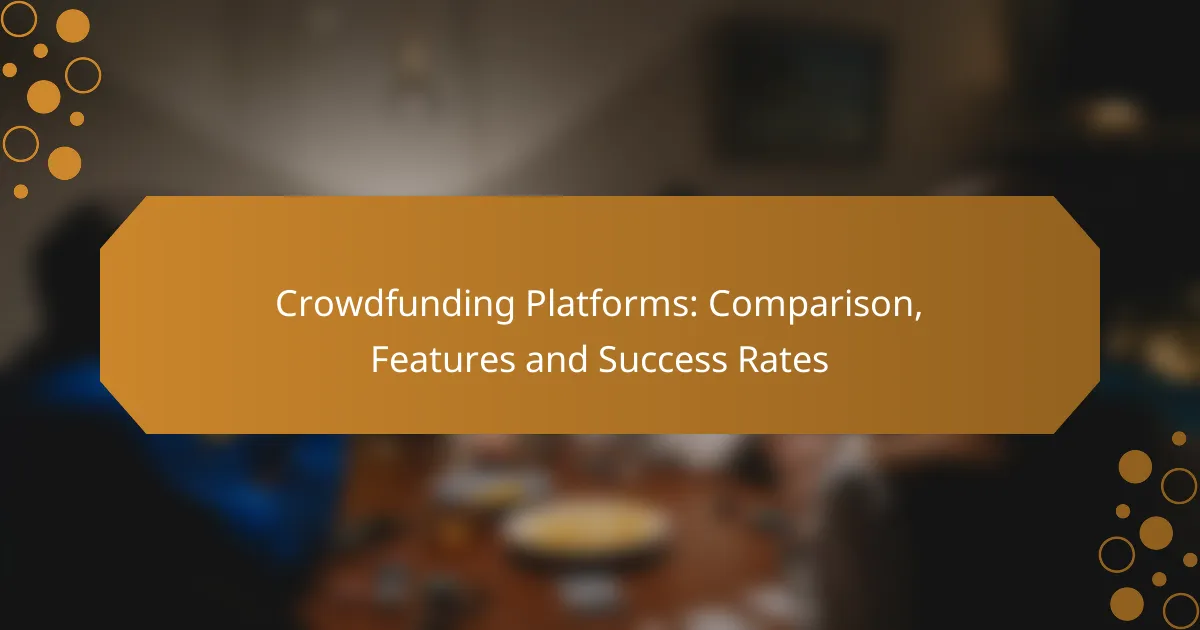Crowdfunding platforms offer diverse options for funding digital projects, with popular choices like Kickstarter, Indiegogo, and Patreon each providing unique features tailored to different goals. When selecting a platform, it’s crucial to evaluate aspects such as fee structures, funding models, and marketing tools, as these can greatly influence your project’s success. Additionally, success rates vary widely across platforms, depending on factors like project type and funding goals, making informed decisions essential for maximizing potential outcomes.
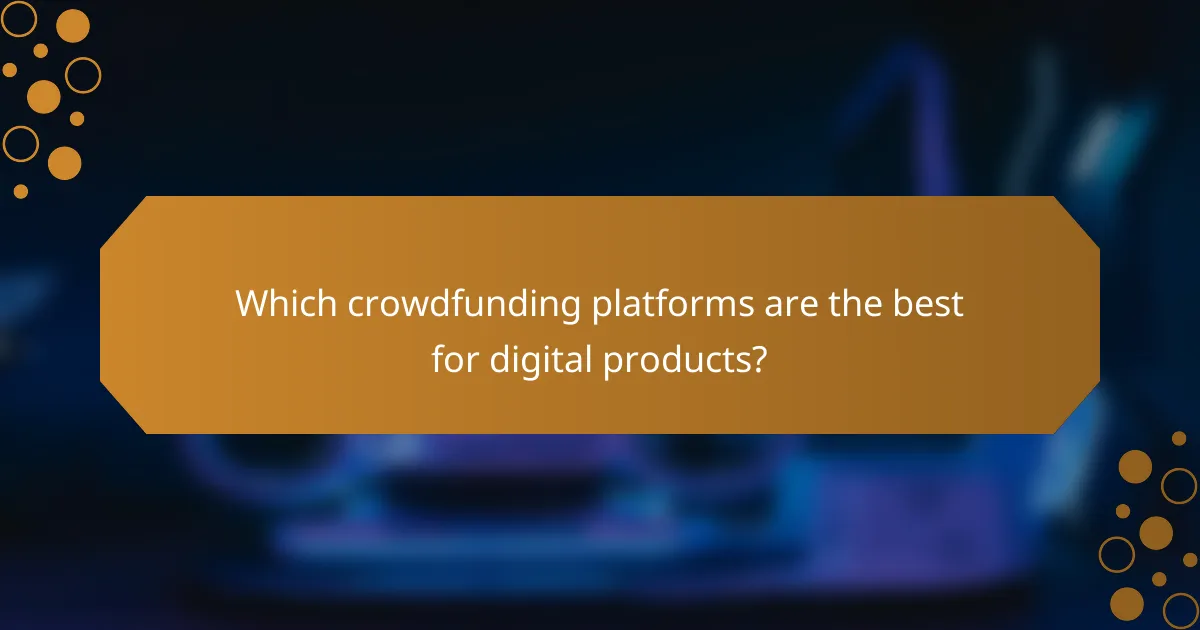
Which crowdfunding platforms are the best for digital products?
The best crowdfunding platforms for digital products include Kickstarter, Indiegogo, Patreon, SeedInvest, and GoFundMe. Each platform offers unique features and caters to different types of digital projects, making it essential to choose one that aligns with your specific goals and audience.
Kickstarter
Kickstarter is a popular platform for creative projects, especially in the digital space. It operates on an all-or-nothing funding model, meaning projects must reach their funding goal to receive any money pledged. This encourages creators to set realistic targets and actively engage with backers.
When using Kickstarter, focus on creating a compelling project page with high-quality visuals and a clear description. Offering attractive rewards can also motivate potential backers. Successful campaigns often raise anywhere from a few thousand to several hundred thousand dollars, depending on the project’s appeal.
Indiegogo
Indiegogo offers more flexibility than Kickstarter, allowing both fixed and flexible funding options. This means creators can keep funds raised even if they don’t meet their goal, which can be beneficial for digital products with lower funding needs.
Indiegogo also supports a wider range of project types, including tech gadgets and software. To succeed, ensure your campaign is well-promoted and consider using Indiegogo’s InDemand feature to continue raising funds after the initial campaign ends.
Patreon
Patreon is designed for creators who want to build a recurring revenue stream through subscriptions. It works well for digital content creators, such as artists, writers, and podcasters, who can offer exclusive content to their patrons.
To maximize success on Patreon, clearly define your tiers and benefits. Engage with your community regularly and provide consistent updates to retain subscribers. Many creators earn anywhere from a few hundred to several thousand dollars monthly, depending on their audience size and engagement.
SeedInvest
SeedInvest is an equity crowdfunding platform that allows startups to raise capital by offering equity in their company. This is suitable for digital product companies looking to scale and attract serious investors.
To use SeedInvest effectively, ensure your business plan is solid and your pitch is compelling. The platform has a rigorous vetting process, so be prepared to demonstrate traction and growth potential. Successful campaigns can raise significant amounts, often in the low millions.
GoFundMe
GoFundMe is primarily used for personal causes but can also be effective for digital products that have a social impact. Unlike other platforms, it does not require a funding goal, allowing creators to receive funds as they come in.
When using GoFundMe, tell a compelling story that resonates with potential donors. Transparency about how funds will be used can increase trust and support. While many campaigns raise modest amounts, those that connect emotionally with their audience can achieve substantial funding.
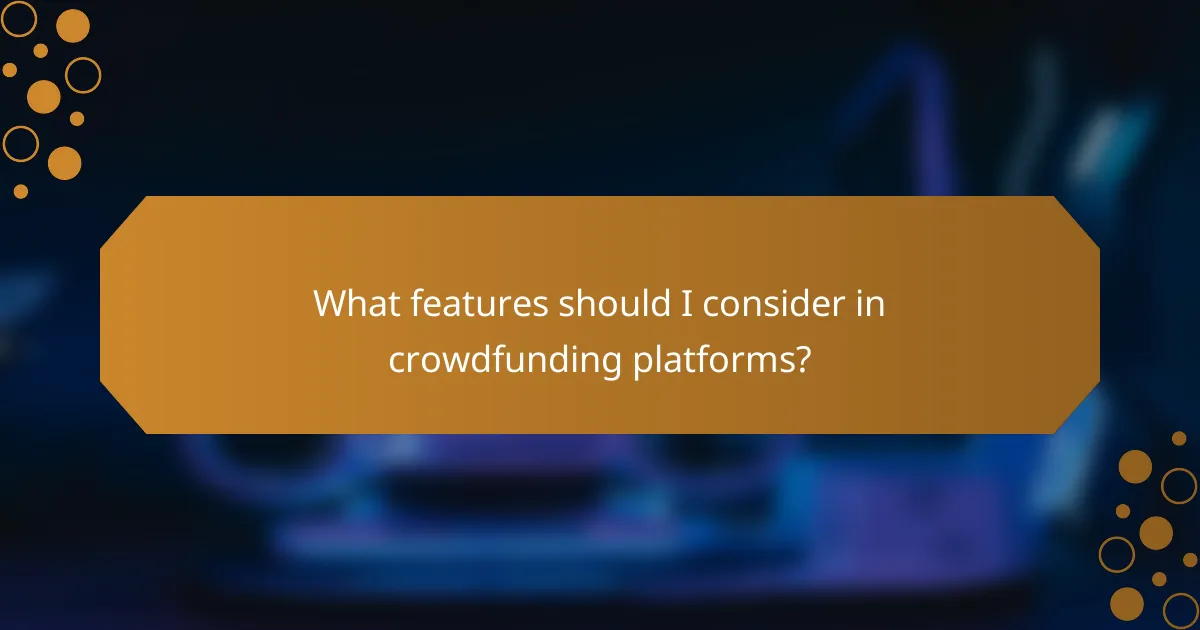
What features should I consider in crowdfunding platforms?
When selecting a crowdfunding platform, consider key features such as fee structures, funding models, marketing tools, and community engagement options. These elements significantly impact your project’s visibility, funding potential, and overall success.
Fee structures
Fee structures vary widely among crowdfunding platforms and can significantly affect your project’s profitability. Most platforms charge a percentage of the funds raised, typically ranging from 3% to 10%, along with payment processing fees that can add another 2% to 5%. It’s essential to understand these costs upfront to avoid surprises later.
Some platforms offer all-or-nothing funding, where you only receive funds if you meet your goal, while others allow you to keep whatever you raise. Choose a fee structure that aligns with your funding strategy and financial goals.
Funding models
Different crowdfunding platforms operate on various funding models, including rewards-based, equity-based, and donation-based crowdfunding. In rewards-based crowdfunding, backers receive non-monetary rewards, while equity-based platforms allow investors to gain ownership stakes in your project.
Consider which model fits your project best. For instance, if you are launching a product, rewards-based crowdfunding might be more suitable, whereas startups seeking investment may prefer equity crowdfunding.
Marketing tools
Effective marketing tools are crucial for attracting backers to your crowdfunding campaign. Many platforms offer built-in promotional features, such as social media integration, email marketing tools, and analytics to track campaign performance. Utilizing these tools can enhance your outreach and engagement.
Look for platforms that provide customizable campaign pages, allowing you to showcase your project visually and narratively. Strong marketing capabilities can significantly increase your chances of reaching your funding goal.
Community engagement
Community engagement features help foster a connection between creators and backers, which can be vital for campaign success. Platforms that facilitate direct communication through updates, comments, and messaging can enhance backer loyalty and support.
Consider platforms that allow you to build a community around your project, as engaged backers are more likely to share your campaign and contribute. Building relationships with your audience can lead to a more successful crowdfunding experience.
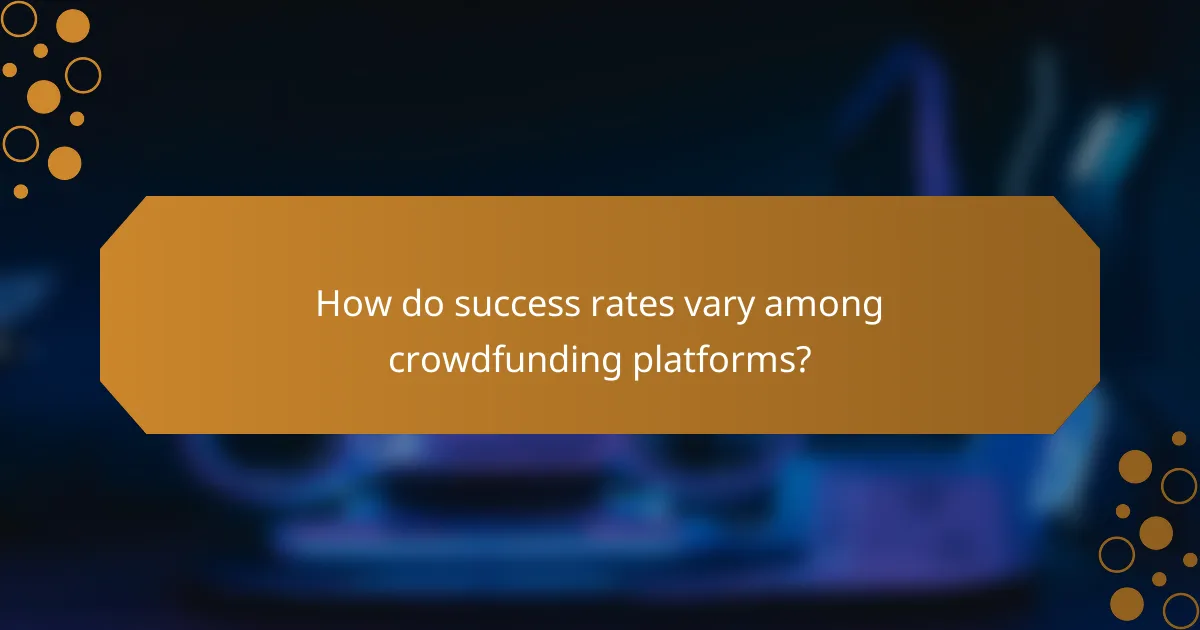
How do success rates vary among crowdfunding platforms?
Success rates among crowdfunding platforms can differ significantly based on various factors, including project type and funding goals. Generally, platforms like Kickstarter and Indiegogo have distinct success metrics, while Patreon operates on a subscription model, affecting how success is defined and measured.
Kickstarter success rate
Kickstarter has a success rate of around 35-40% for projects that reach their funding goals. This platform is primarily geared towards creative projects, and all or nothing funding means that projects only receive funds if they meet their target. This model encourages backers to support projects they believe in, but it also means that many projects fail to secure funding.
To improve chances of success on Kickstarter, creators should focus on building a strong campaign narrative, engaging potential backers early, and setting realistic funding goals. Offering attractive rewards can also motivate backers to contribute.
Indiegogo success rate
Indiegogo’s success rate varies widely, typically ranging from 10-30% depending on the project category. Unlike Kickstarter, Indiegogo offers flexible funding options, allowing creators to keep funds even if they don’t meet their goal. This can be advantageous for projects that may require less than their initial target to proceed.
To enhance success on Indiegogo, it’s beneficial to leverage social media for promotion and to create a compelling video to explain the project. Clear communication about how funds will be used can also help build trust with potential backers.
Patreon success rate
Patreon operates differently, focusing on ongoing support rather than one-time funding goals. Success on Patreon is often measured by the number of active subscribers rather than project completion. Many creators find success by consistently delivering value to their patrons through exclusive content and community engagement.
To thrive on Patreon, creators should regularly interact with their patrons and provide unique rewards that justify the subscription cost. Setting clear tiers for support can also help potential patrons understand the value they receive at each level.
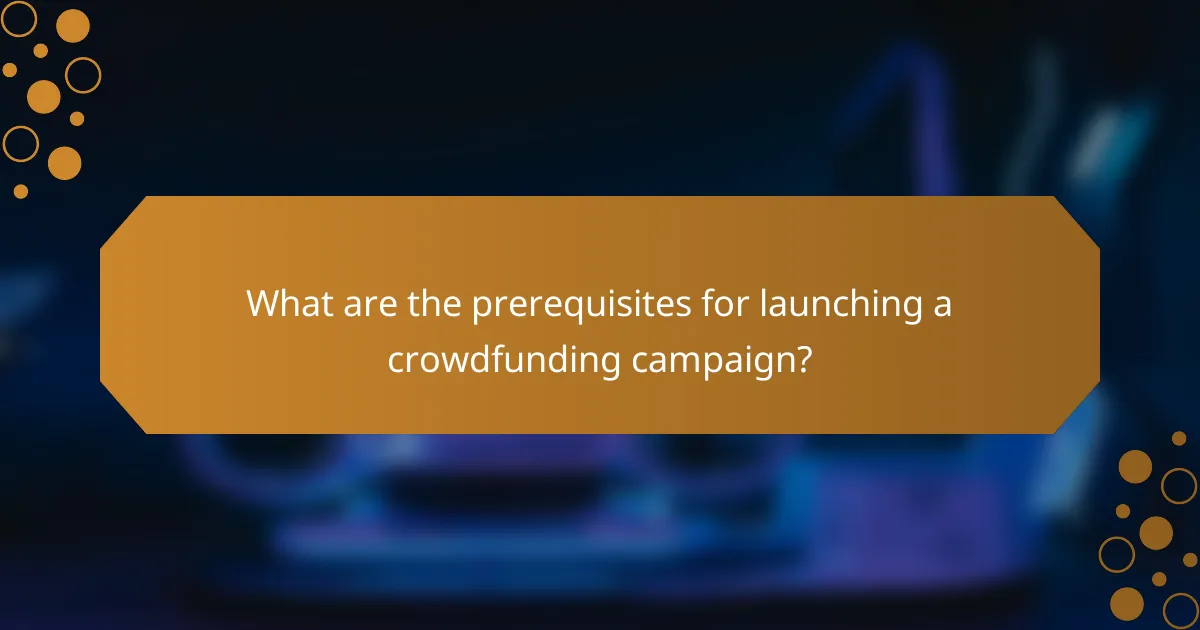
What are the prerequisites for launching a crowdfunding campaign?
To successfully launch a crowdfunding campaign, you need a clear project idea, a defined target audience, and a well-structured plan. Understanding these prerequisites helps ensure that your campaign is both appealing and effective in reaching its funding goals.
Market research
Conducting thorough market research is essential for identifying your target audience and understanding their preferences. Analyze similar campaigns to see what worked and what didn’t, paying attention to funding amounts, backer engagement, and promotional strategies.
Utilize surveys or social media polls to gather insights directly from potential backers. This feedback can guide your campaign messaging and help you tailor your rewards to meet their interests, increasing the likelihood of success.
Campaign planning
Effective campaign planning involves setting realistic funding goals, creating a compelling narrative, and developing a timeline for your campaign. Aim for a funding target that reflects your project’s needs while remaining achievable based on your market research.
Outline your campaign’s key milestones, including pre-launch marketing, the campaign duration, and post-campaign fulfillment. Consider creating a checklist to ensure all elements, from promotional materials to reward structures, are in place before you go live.
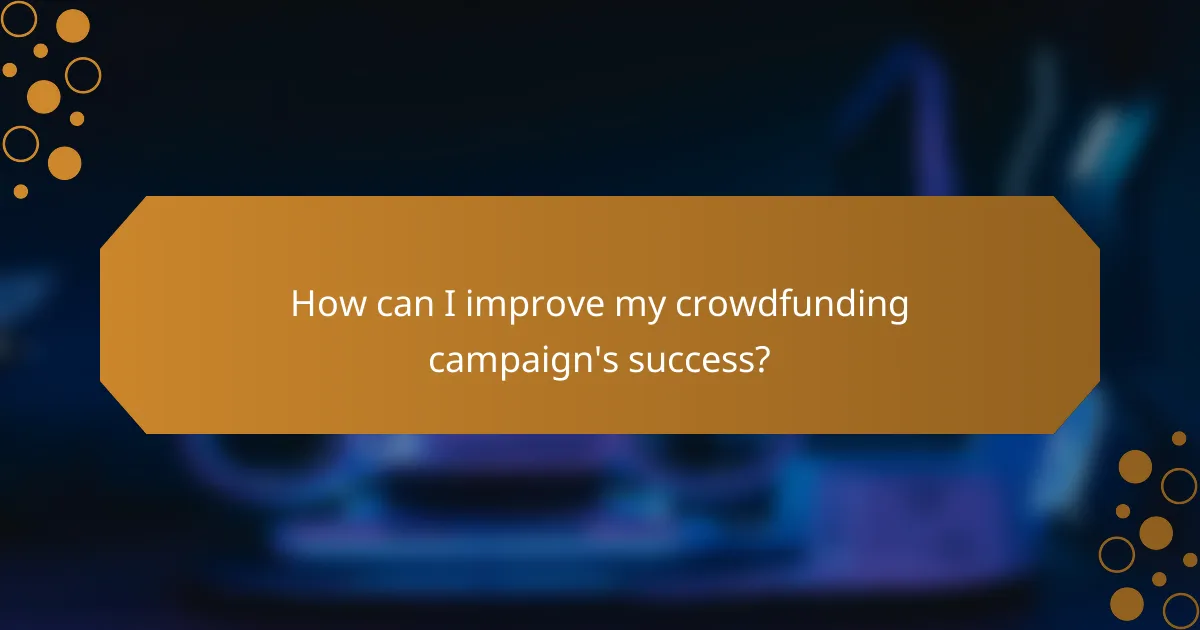
How can I improve my crowdfunding campaign’s success?
To enhance your crowdfunding campaign’s success, focus on clear messaging, engaging visuals, and effective outreach strategies. Understanding your target audience and setting realistic funding goals are crucial for attracting backers.
Set a realistic funding goal
Establishing a realistic funding goal is essential for your campaign’s success. Consider the costs involved in your project, including production, shipping, and platform fees, and set a target that covers these expenses while remaining achievable. Goals in the low thousands of USD often resonate well with backers.
Research similar campaigns in your niche to gauge typical funding levels. This can help you find a balance between ambition and feasibility, ensuring you don’t set your sights too high or too low.
Create a compelling story
A compelling story can significantly increase your campaign’s appeal. Share your passion for the project and explain why it matters to you and potential backers. Use personal anecdotes and relatable experiences to connect emotionally with your audience.
Incorporate visuals such as images and videos to enhance your narrative. A well-produced video that outlines your vision and showcases your product can capture attention and encourage sharing across social media platforms.
Engage with your audience
Engagement is key to building a supportive community around your campaign. Regularly update backers on your progress and respond promptly to comments and questions. This interaction fosters trust and encourages more people to support your project.
Consider hosting live Q&A sessions or using social media to interact with potential backers. Engaging content, such as behind-the-scenes updates or sneak peeks, can keep your audience invested in your journey.
Leverage social media and marketing
Utilizing social media and marketing strategies is vital for reaching a broader audience. Create dedicated pages for your campaign on platforms like Facebook, Instagram, and Twitter to share updates and engage with followers. Use targeted ads to reach specific demographics that align with your project.
Consider collaborating with influencers or bloggers in your niche to expand your reach. Their endorsement can lend credibility to your campaign and attract new backers who trust their recommendations.
Offer attractive rewards
Offering attractive rewards can motivate backers to contribute to your campaign. Design a tiered reward system that provides value at various contribution levels, from small tokens of appreciation to exclusive products or experiences for higher pledges.
Ensure that the rewards are relevant to your project and appealing to your target audience. Limited-time offers or early bird specials can create urgency and encourage quicker funding decisions.
